new posts in all blogs
Viewing: Blog Posts Tagged with: goddess, Most Recent at Top [Help]
Results 1 - 13 of 13
How to use this Page
You are viewing the most recent posts tagged with the words: goddess in the JacketFlap blog reader. What is a tag? Think of a tag as a keyword or category label. Tags can both help you find posts on JacketFlap.com as well as provide an easy way for you to "remember" and classify posts for later recall. Try adding a tag yourself by clicking "Add a tag" below a post's header. Scroll down through the list of Recent Posts in the left column and click on a post title that sounds interesting. You can view all posts from a specific blog by clicking the Blog name in the right column, or you can click a 'More Posts from this Blog' link in any individual post.

By:
nicole,
on 9/22/2015
Blog:
the enchanted easel
(
Login to Add to MyJacketFlap)
JacketFlap tags:
fantasy,
red,
painting,
acrylic,
goddess,
etsy,
kawaii,
fire,
canvas,
whimsical,
traditional,
flames,
brunette,
elements,
the enchanted easel,
fine art america,
lotus flowers,
nuvango,
Add a tag
 |
serafina~fire goddess
11x14 acrylic on canvas
©the enchanted easel 2015 |
i thought it might be fun to take on the four elements (in between commissions), so i began with a self-portrait of sorts...the true definition of a fire sign.
meet serafina, the goddess of fire. PRINTS (AND SUCH) can be found through the shop links
here. also, the ORIGINAL PAINTING is FOR SALE.
contact me if interested and please place the word SERAFINA in the subject line so i don't mistake it for spam/junk mail.
i'm hoping to get to the remaining elements (air, water and earth) SOON! :) currently working on a couple commissions....
Read the rest of this post
By:
mrana,
on 12/18/2009
Blog:
Bit by Bit
(
Login to Add to MyJacketFlap)
JacketFlap tags:
illustration,
holidays,
Christmas,
typography,
Moleskine,
Goddess,
Drawings,
BotanicalArt,
cards,
Daily Sketches,
Fruit,
Dabbling,
text design,
typography design,
Colored Pencil,
artwork,
floating lemons,
coloured,
Christmas orange,
clementines,
Natascha,
Add a tag

Last week we bought a small basketful of Clementines from the weekly village market. They look and smell so bright and cheerful and summery, lift the spirits even on cold winter days, and are absolutely irresistible. I've since discovered that they are also called Christmas Oranges as they're available from mid-November till January. Sweet and seedless they're teeny pop-in-the-mouth treats. Had to draw them of course.
This was done in coloured pencil on a large-scale moleskine sketchbook that I'm now quite in love with. I haven't really finished the drawing and I hate not completing something to my satisfaction once I've started it, but this will just have to stay as is, as I am away for a couple of weeks as of tomorrow and needed to post this in order to wish everyone a lovely Christmas and New Year!
I'll also add my latest customer/friend requested text designs, Natascha and Goddess. Enjoy the holidays! Cheers.

Natascha products at Floating Lemons Typography at Zazzle

Goddess products at Floating Lemons Typography at Zazzle

By: Stacy Dillon,
on 8/10/2009
Blog:
Welcome to my Tweendom
(
Login to Add to MyJacketFlap)
JacketFlap tags:
greed,
fantasy,
politics,
racism,
Goddess,
thieves,
Alfred A. Knopf Books for Young Readers,
arc 10/09,
cobblers,
socio economic class,
Roderick Townley,
Add a tag
 How can you not love this title? And this gorg cover?
How can you not love this title? And this gorg cover?
Aplanap is one heck of a place to live. Seemingly quaint, it’s known for its “tilted streets, cuckoo clocks, and Finster cheese…” (arc p.3) yet it harbors a bit of a dark secret. Okay, not so much a secret, but a mayor who is slightly certifiable in his disdain for beggars (who are instantly banished to the working jail of Mount Xexnax) and his love for his greedy wife Ludmilla.
Ludmilla is quite fond of gems, and since she is the mayor’s wife, she need not pay for anything that she wants. When the mayor hears about an exquisite shoe that local shoemaker Grel has fashioned out of all sorts of blue gemstones, he insists on seeing it. Not surprisingly, he then wants it wrapped and delivered to his sweet Luddy. Grel refuses and the mayor reminds him of the agreement he made prior. Grel had saved the life of a pickpocket boy named Hap by promising to apprentice him on the agreement that he would in turn give Luddy any shoes that she wants. Grel stands his ground, however, since the stranger who commissioned this one shoe paid for it in full – he asks the mayor if he really would like to steal it (thievery being frowned upon in Aplanap by way of Mound Xexnax as well).
Before long a curse seems to fall on the sleepy little village. The weather turns making tourists scarce, and soon there are actually beggars on the street. Hap feels a kinship with a beggar girl who he spies, and tries to help her several times before she gets caught by the mayor’s police for begging. Hap remembers Grel’s kindness to him, and decides that taking a gem from the shoe that has never been picked up to pay the girl’s fine is worth the risk. What Hap doesn’t count on is all of the gems fading into regular river pebbles on the removal of the single stone. Hap again is charged as a thief, this time with the disastrous sentence of Mount Xexnax.
Roderick Townley has written a fantastical adventure that is filled with action, close calls, magic and a dash of romance. Truly a rollicking read, The Blue Shoe has equal appeal to boys and girls, and is a fun single volume (shocking!) fantasy. I found myself reading well into the night wanting to see what Hap and his friends were going to do next. Illustrations by Mary Grand Pre bring this book to the next level. While I read the arc version, the first edition will be printed in blue ink and have a cover worthy of the shoe. Good versus Evil hasn’t been so rich in a while!
Alfred A. Knopf Books for Young Readers, thieves, socio economic class, race struggles, fantasy, Goddess, greed, cobblers, politics, arc 10/09
Natalie L Sin has a cool post about some God like things she has done as a writer... And being a Goddess (ahem!) myself, I thought I'd steal the idea and do a top ten of my own evil and strange deeds. All fictional of course.
10. Stopped zombies going to the Oscars.
9. Sent a bunch of senile seniors to the moon.
8. Ran down a giant chicken.
7. Threw a bunch of dead zombie Dolly Parton impersonators out of a plane.
6. Nuked my home town.
5. Dismantled a homicidal robot.
4. Removed the face of a serial killer.
3. Flown half-way across the U.S. on a neon sign.
2. Turned a kid into a paper doll.
1. Stopped time.
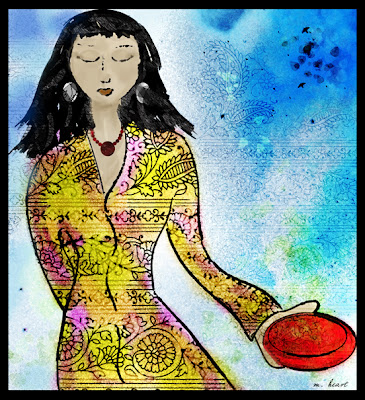 waiting for the birds...
waiting for the birds...
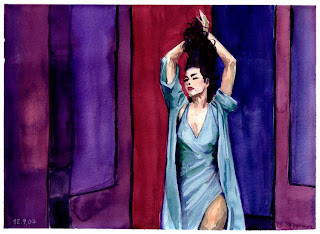 From a film which was, quite frankly, very disparaging towards women. In spite of that, this woman in the opening credits managed to appear dignified and powerful. That's a feat in a film like that!
From a film which was, quite frankly, very disparaging towards women. In spite of that, this woman in the opening credits managed to appear dignified and powerful. That's a feat in a film like that!
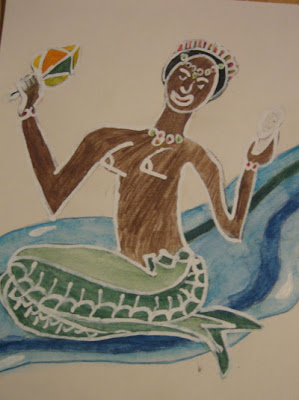
Oshun (Yoruba) is the Goddess of the rivers that sustain life. She rules love, beauty and the arts, especially dance.
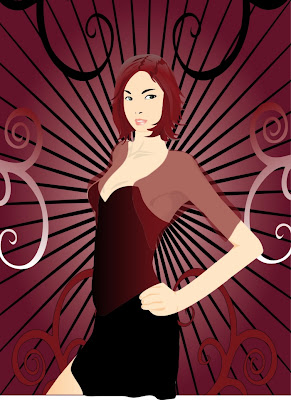
This is one of my fashion girl illustrations! When I saw the topic goddess I had to post this one..one of my favourites :) Hope you like my little goddess :P

This is my first post :) I'm really happy to have join the Monday Artday blog; here is my «Goddess», Enjoy!
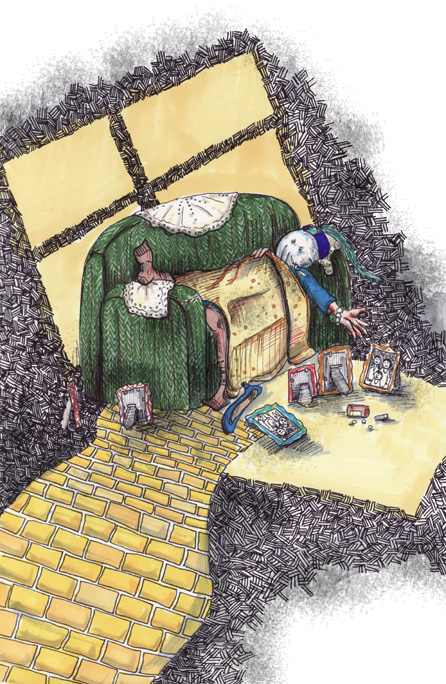
The challenge on
Monday Artday this week is "
goddess"
In the 1930s, Hollywood placed many actresses on the "goddess" pedestal. There was
Barbara Stanwyck,
Carole Lombard,
Betty Grable,
Jean Harlow,
Lana Turner and many others. There were other actresses, appearing in hundreds of movies, who never acheived "goddess" status. Clara Blandick falls into this category.
Clara was born in 1876 on a ship, captained by her father, harbored in Hong Kong. Her parents eventually settled in Quincy, Massachusetts and she began her acting career at age 24. After numerous successes in many stage plays, Clara moved to Hollywood in 1929. Though she landed roles like Aunt Polly in the 1930 film
Tom Sawyer (a role she reprised in the 1931 film
Huckleberry Finn), she spent much of the decade as a character actor, often going uncredited. At a time when many actors were permanently attached to a single studio, Clara played a wide number of bit parts for almost every major Hollywood studio. In 1930, she acted in nine different films. In 1931 she was in thirteen different films. It's impossible to make an exact tally of the films in which Clara appeared. A reasonable estimate would fall between 150 and 200.
Her most famous role was that of Dorothy's Aunt Em in 1939's
The Wizard of Oz. Clara filmed all her scenes in a single week, for which she was paid $750. Although it was a small part, the character was an important symbol of protagonist Dorothy's quest to return home throughout the film. After
The Wizard of Oz, Clara returned to her staple of character acting in supporting and bit roles. She would continue to act in a wide variety of roles in dozens of films, including a surprised customer in the 1941 Marx Brothers film
The Big Store and a cold-blooded murderer in the 1947 mystery
Philo Vance Returns. Her final two roles both came in 1950 – playing a housekeeper and a landlady in
Key to the City and
Love That Brute respectively. Poor health forced Clara to retire soon after.
Throughout the 1950s, Clara's health steadily began to fail. She started going blind and began suffering from severe arthritis. On April 15, 1962, she returned home from Palm Sunday services at her church. She began rearranging her room, placing her favorite photos and memorabilia in prominent places. She laid out her resume and a collection of press clippings from her lengthy career. She dressed immaculately, in an elegant royal blue dressing gown. Then, with her hair properly styled, she took an overdose of sleeping pills. She lay down on a couch, covered herself with a gold blanket over her shoulders, and tied a plastic bag over her head. Clara left the following note: “
I am now about to make the great adventure. I cannot endure this agonizing pain any longer. It is all over my body. Neither can I face the impending blindness. I pray the Lord my soul to take. Amen.” Her body was found by her landlady.
After researching Clara and her chosen method and ritual of dying, I have watched her in
The Wizard of Oz differently than before.
She will never be remembered as a silver screen goddess.

By: Lisa Alvarado,
on 10/17/2007
Blog:
La Bloga
(
Login to Add to MyJacketFlap)
JacketFlap tags:
spirituality,
poetry,
community building,
goddess,
women of color,
women's studies,
Teatro Luna,
Virgen de Guadlupe,
Virgen de Guadalupe,
community theater,
Martin Espada,
Add a tag

Marion Woodman is a Jungian analyst—and is one of the most inspiring voices in the global movement for peace. Here she joins forces with Elinor Dickson, Director of Psychological Services at St. Michael’s Hospital, Toronto to produce an informed and penetrating investigation of a source of spiritual and creative power, not popular in Western circles. In Dancing in the Flames, they point to a constellation of archetypal ideas which they hope will be a source to inspire and inform: the mythical complex of the Dark Goddess. Their book operates on two levels, as a guide for individual transformation and ultimately transforming society.
The core of the book is a cluster of chapters using psychoanalytic material that draws on the mythology of the Dark Goddess. Mind you, the frame of reference is European, but Woodman does attempt to bring in a non-Western perspective, honoring as best she can the thousand years of Hindi veneration to Kali, the root source for this archetype.
At a broad-brush level, this initially involved the matriarchal phase, a belief in a living world where everything in nature held spirit-life flowing from source, the Great Mother. This was followed by the emergence of a separate. individual 'self', then the formation patriarchal and hierarchical power structures.
Throughout the early part of this history, the archetype of this Goddess progressively is split off more and more from that of the Great Mother, emerging as a her polar opposite---killer, and scourge. In reality, it's the cleansing aspect of the Good/Bountiful/Great Mother. The split of the Great Mother vs. Dark Mother mirrors that schism between matriarchy and patriarchy, the body and the spirit.
The authors make the case that in the period that followed, both the Great Mother and the Goddess are repressed, and driven into the "murky depths of our unconscious." Yet the culture of the Goddess lives on, underground, in succeeding centuries. It eventually finds expression, despite repression, in the form of the Black Virgin from the twelfth century onwards. And I would argue, our own veneration of La Virgen, of Tonatzin, who survived colonization, a remains a vital life force in the Chicano/Mejicano soul and psyche.
The authors make an impassioned case that society as a whole must reclaim the Dark Goddess. To underscore, they turn to personal analytic material, allowing the reader to make their own contact with the goddess archetype. The mythological aspects of Virgin, Mother and Crone, making up the European triple goddess, are followed through their appearance in the therapies of both men and women, these images used as tools in the process of personal evolution. In my experience of Eurocentric, new-age feminism, its subtle racism links creativity/goodness with the idea of light and so I found it powerful and liberating to be reminded of the imagery of the holy darkness, its power to cleanse, nourish and renew.
This idea of darkness, again, is no stranger to indigenous ideas of the Mother--She Who Is. I have a personal source of connection to the Santeria/Yoruba deity of Oya Yansa. Oya is also also Dark Goddess, keeper of the whirlwind, sweeping clean all that is decayed, corrupt. It was important for me to reframe my own ideas of Mother, particularly in contrast to the long-suffering Virgin of my youth. This book was a thought-provoking resource, stirring up a fleshy, full-bodied, powerful female deity, one with deep hunger, deep ability to consume, transmute and transform.
The authors give a picture of integration inspired by the qualities of the Dark Goddess, a process in which fear of death, fear of nature, and fear of our own femininity (whether we are men or women) are reconciled in the dark. They stress the dangers of yearning for a world of "pure" spirit and "light," a state where in our yearning for perfection, we confuse a certain kind of "perfection" with wholeness.
I would further challenge the notion of light equaling perfection---light without the regenerative power of darkness is half of what is and only half. And under the harshness of unending, unshrinking light, all fades and withers away, spent beyond resources, starving for rest, for the dream world, for losing oneself and finding the body made anew.
One of the most interesting parts in the book subdivides the process according to the traditional chakra system, while still basing the account firmly on the actual material of analysis. From this viewpoint, integration is seen as a process of “building the subtle body,” of embodying spirit in a complete and integrated way.
The key step in this process, for the individual, involves the recognition of our own autonomy, the acceptance of ourselves, and the finding of our own voice. For this to happen, "it takes great resolve to enter the darkness of our own chaos, to give up the familiar path and begin to trust in our own experience. The recognition and unconditional love of oneself is never a selfish journey."
It's a journey of seeking awareness, increasing confluence between those things we normally separate as "physical" and "spiritual." At the end, the book returns to the societal level, where the authors’ believe the protests of the Sixties "were the seeds, at a culturally recognized level, of a movement based on hope for a more meaningful existence.... What began as a protest has become a challenge, a challenge that will involve not only technology, but a new understanding of human mythology."
Depending on how we choose to phrase it, either ideas of ' science' must be revamped to include experiencing this relatively unused 'female' approach, or needs to be blended into a larger view that gives equal status to this view. The authors’ account at the end gives us a start -- some tools that may enable us to do this. They give us immense hope, and also a profound challenge. This new vision is not one that we can dream up intellectually: it can be reached only by transformation, only if we "throw ourselves into the flames and dance in the refining fire..."
Our traditional ideas of 'science' stresses the intellect, the rational—in archetypal terms, a 'masculine' construct. It operates with ideas of impersonal, 'objective' discovery and 'absolute' truth. While it's an important way of knowing, it has limits as a basis for a new world view. There are deep questions that emerge. How do we construct gender and identity? How are those concepts linked to to behaviors like violence and passivity? How can we integrate complicated, contradictory ideas of male/female that include ‘dark’ and healing forces in both?
This book kept me up at night. It was another piece of encouragement to let go, to delve deep, and look at what's revealed without flinching. I'm always on the lookout for things that will strengthen me, as well as shake me up. The themes of violence, sexualized violence in particular, are shot through the fabric of this American life, and to ignore them is one darkness I find unacceptable. Dancing in the Flames provides a kind of comfort, as well as a challenge.
ISBN-10: 1570623139
ISBN-13: 978-1570623134
xxxxxxxxxxxxxxxxxxxxxxxxxxxxxxxxxxxxxxxx

| | Presented byCHICAGO FOUNDATIONFOR WOMEN'S
Latina Leadership Council|
6:30 p.m. wine and cheese reception
8-9:30 p.m. performance
Friday, Nov. 9
Chicago Dramatists
1105 W. Chicago Ave.
Chicago
Call (312) 577-2801 ext. 229. Tickets are $45.
Proceeds from this event benefit the Unidas Fund
of the Latina Leadership Council.
No refunds or exchanges.
A world premiere production, "MACHOS"
is an interview-based play about
contemporary masculinities.
As always, Teatro Luna asks
hard-hitting questions, such as:
Exactly how did you learn to use the urinal?
"MACHOS" presents a range of true-life stories
with Teatro Luna’s trademark humor and unique
Latina point-of-view. "MACHOS" follows
Teatro Luna's critically-acclaimed shows
"S-E-X-OH" and "LUNATIC(A)S."
It moves beyond the everyday stereotypes
of gender, offering a complex look at how 50 men
(and eight Latina women) learned how to be men.
Performances are drawn from interviews
with 50 men nationwideand performed
by an all-Latina cast in drag.
After the performancethere will
be a reception with director Coya Paz and the actors.
Featuring Belinda Cervantes,
Maritza Cervantes,
Yadira Correa,
Gina Cornejo,
Ilana Faust,
Stephanie Gentry-Fernandez
and Wendy Vargas.
Learn more about the Latina Leadership Council
of Chicago Foundation for Women.
Chicago Dramatists is wheelchair-accessible.
If you have other accesibility needs or questions,
please contact Marisol Ybarra by Nov. 6 at
(312) 577-2836 / TTY (312) 577-2803 or [email protected].
The 17th Annual Gwendolyn Brooks
Conference on Black Literature and Creative Writing
Fine Fury: Celebrating Gwendolyn Brooks at 90
October 17-20 2007 Chicago State University
As for that other kind of kindness,
if there is milk it must be mindful.
The milkofhumankindness must be mindful
as wily wines.
Must be fine fury.
Must be mega, must be main.
-- from Young Afrikans (of the furious)
by Gwendolyn Brooks
Featuring:
Sonia Sanchez
Martin Espada
Ed Roberson
Tayari Jones
Donda West
Cheryl Clarke
Julius E. Thompson
Haki R. Madhubuti
Sterling Plumpp
Angela Jackson
Sandra Jackson-Opoku
Margo Crawford
Camille Dungy
Jacqueline Jones LaMon
Evie Shockley
Adrian Matejka
Gregory Pardlo
Randall Horton
Kelly Norman Ellis
Nnedi Okorafor-Mbachu
Bayo Ojikutu
Kalisha Buchanon
Workshops by Martin Espada and others.
For registration information visit
www.csu.edu/gwendolynbrooks or call 773-995-3750.
Lisa Alvarado |
|
|
...and he brought - another lovely Goddess doll from dear Ms Robyn...like the last one, she must have taken a detour in her travels, as she was supposed to arrive in time for Christmas, but arrived safely in January. Here she is sat with Duncan, waiting for the 2007 festivities. 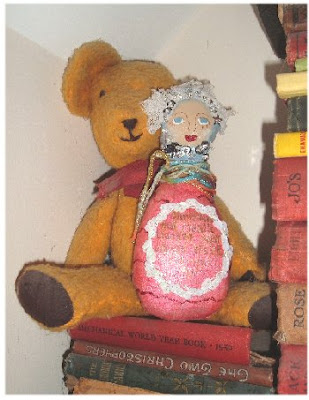
...bizarre yet scrummy chocolate mushroooms from the Laundry Fairy, these are the last survivors saved specially for the photo...  ...and the strangest taste experience I have had in 2007, Hot and Sour soup - I am not sure how something which set my mouth on fire could taste so delicious. By the end of the bowl my lips felt as if they had had a triple injection of collagen. But it was definitely worth the pain...
...and the strangest taste experience I have had in 2007, Hot and Sour soup - I am not sure how something which set my mouth on fire could taste so delicious. By the end of the bowl my lips felt as if they had had a triple injection of collagen. But it was definitely worth the pain...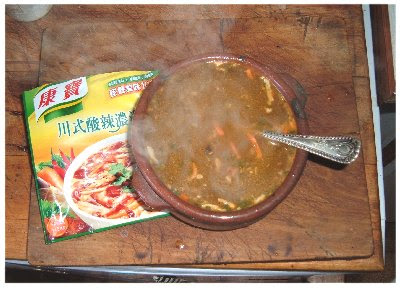 ...and on Valentine's Day, from the Queen of SOSF, the ever generous Tara of SIlver Apples...her own delightful handmade soaps (WHERE does she find the time!) and general hearty-loving-goodies...all packed beautifully as always...
...and on Valentine's Day, from the Queen of SOSF, the ever generous Tara of SIlver Apples...her own delightful handmade soaps (WHERE does she find the time!) and general hearty-loving-goodies...all packed beautifully as always...
...incuding this hot chocolate kit, with a frighteningly large dried chilli - just look at the size of it - it could serve a pillow for a newborn baby! I am somewhat in awe of it, and prod it from time to time to see if it is alive...
 (There was something else especially wonderful in this parcel, but I don't think I can show it yet, suffice to say that Tara, you are amazing, and everyone is going to love it when you can spill the beans!)
(There was something else especially wonderful in this parcel, but I don't think I can show it yet, suffice to say that Tara, you are amazing, and everyone is going to love it when you can spill the beans!)
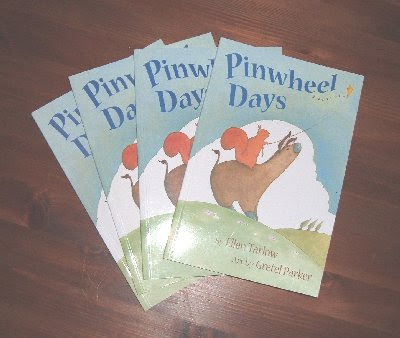
...and finally, my copies of 'Pinwheel Days', which has finally hit all good USA bookshops everywhere, but especially your local Amazon. I am finally published!

Goddess of the Americas
Castillo, Ana (ed.)
Riverhead Books, 1997
ISBN-10: 1573226300
ISBN-13: 978-1573226301
This a brilliant collection celebrating the love of and devotion to the enduring influence of the Virgin of Guadalupe. Castillo includes male and female writers, agnostics, traditional Catholics, feminists, and Santeras in this eclectic homage. This anthology contains essays, memoir, poetry, and rhetoric celebrating a complicated relationship with our diosa, one that is much less European and traditionally Catholic, something much more than that. This is a deity that is full-bodied, sensual, actively involved in the thrum and unraveling and reclamation of the world.
In the preface, Castillo writes that this brown-skinned Mary appeared in 1531; but in reality, existed as Tonatzin, a thousand years before the conquest. The thread that weaves these essays together, is the fascination with the ways in which Tonatzin, the moon goddess, morphed into this particular image of Mary. She is essentially Latina, essentially an emblem of indestructible indigena roots, which survived through a syncretic practice. (Much like the ways Mejicanos/Chicanos themselves survived the conquest.)
Authors such as Elena Poniatowska, Luis J. Rodriguez, Sandra Cisneros, Denise Chavez, and Gloria Anzaldua write with clarity, precision and grace, depicting a 'Virgin' that has survived the conquest and embodies a multiplicity of identities, based on the multitude of goddesses that are her antecedents. Shaped in their image, this goddess is rooted in the cyclic and eternal, sprung from our roots, from the religion that held us before there was religion. This goddess is one with qualities the colonizers could not imagine, let alone control. This Virgin is an amalgam of lover, consort, liberator, guardian of the living and the dead, wellspring of the revolutionary.
Of particular interest to me was Sandra Ciseneros' essay entitled, 'Guadalupe the Sex Goddess'. It in, she traces the Virgin's pre-Columbian roots as icon of fertility and sexuality, central to a cosmology in which female sexuality was valued, not denigrated. In that cosmology, Guadalupe's antecedents included Tonatzin, the moon Goddess who embodies the feminine principle of cyclical re-creation. She (Guadalupe) is also linked to Tlazolteotl, patron of sexual pleasure and Tzinteotl, goddess of the rump. Lastly, there is a connection Tlaelcuani, the filth-eater, she who transforms the ugly, the corrupted, into the sanctified and renewed.
Cisnero on her significance:
When I look at the Virgin of Guadalupe now, she is not the Lupe of my childhood, no longer the one in my grandparent's house in Tepeyac, nor is she the one of the Roman Catholic Church.
...Like every woman who matters to me, I have had to search for her in the rubble of history. And I have found her. She is Guadalupe the sex goddess, one that makes me feel good about my sexual power, my sexual energy, who reminds me I must...speak the most basic, honest truth...write from my panocha.' (p.49)
This is the vivid imagery, the hidden history I need in order to shape a reconstruction of identity, one woven woven with both Catholic and more ancient threads. This is the Goddess that saves everywoman, blesses everyman, and transforms physical violence and abuse, celebrating the sacred, sexual body.
A formidable read. This book has helped me think about what in means to be a Latina, in a personal and epic sense.




















I saw this one at ALA and am really looking forward to it. I'm glad it lives up to my expectations. Thanks for the review.
Hey GBTQ: I really liked it! I can't wait to see the final product.